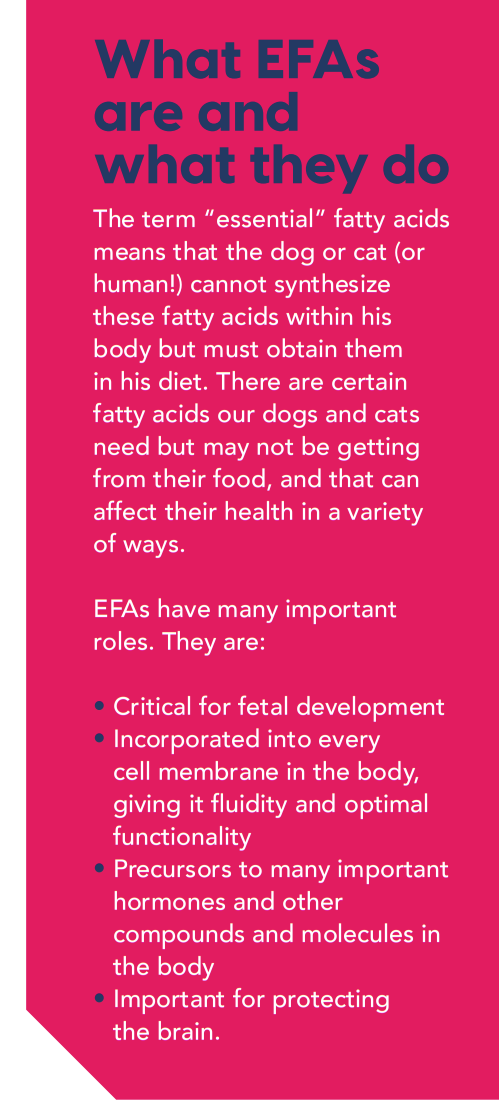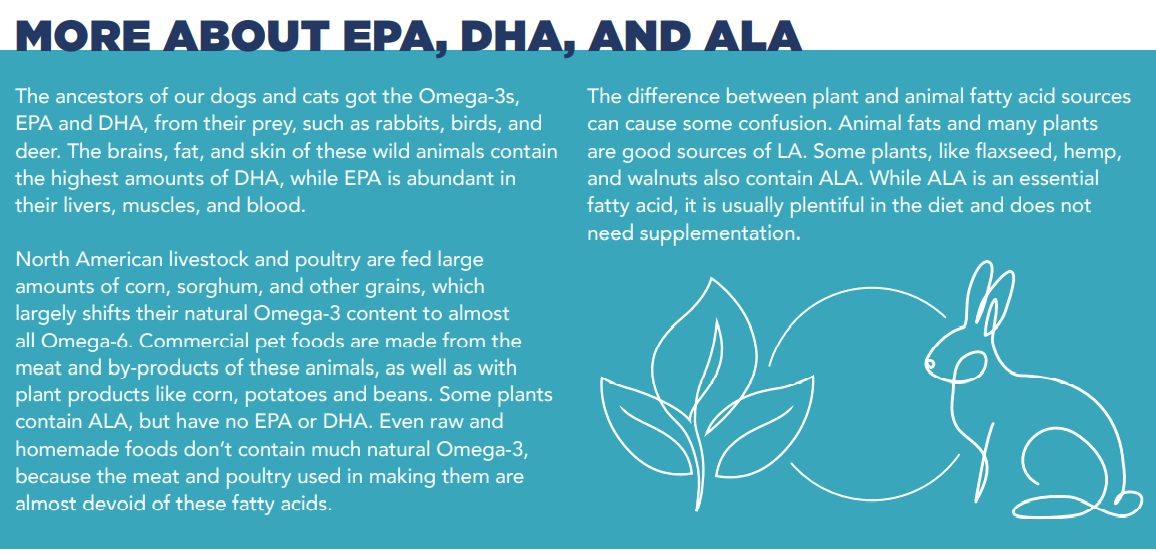Essential fatty acids for dogs and cats with arthritis

Which essential fatty acids (EFAs) do dogs and cats need as supplements, and how do they work to help alleviate the inflammation associated with arthritis?
As our dogs and cats age, they are increasingly likely to develop osteoarthritis and other joint problems. There are many natural and holistic ways to help keep our animals mobile and free of discomfort, and certain essential fatty acids (EFAs) play a supporting role. Let’s look at how these EFAs can help ease your dog or cat’s arthritis and improve his joint health.
Which fatty acids are essential to dogs and cats?
Only two fatty acids are essential for dogs: alpha-linolenic acid (ALA, an Omega-3 fatty acid from plants) and linoleic acid (LA, an Omega-6 fatty acid found in plants and animals). Cats also need arachidonic acid (an Omega-6). From these fundamental molecules, the body theoretically makes the other fatty acids it needs.
In addition, two other fatty acids are considered essential during development (pregnancy, lactation, and growth) — the Omega-3s, EPA and DHA (eicosapentaenoic acid and docosahexaenoic acid).

Theoretically, ALA is a precursor for EPA and DHA. However, carnivores like dogs and cats aren’t very good at making that conversion. Newborn puppies can manufacture DHA, but they lose that ability at weaning. Dogs convert less than 5% of ALA to EPA, and none to DHA. Cats are even more limited.
While there is a huge body of scientific evidence showing how important EPA and DHA are for optimal health beyond the early life stages, they are not technically essential. However, because EPA and DHA are so extremely beneficial, let’s look at what they do and why you may want to add them to your dog or cat’s diet. Since we can be confident that, no matter what our animals are eating, they are getting enough ALA and Omega-6s in their food, the only fatty acids they really need more of are the Omega-3s.
Omega-3s and Omega-6s — their relationship to inflammation
Omega-3 fatty acids are said to be “anti-inflammatory” and Omega-6s “pro-inflammatory” because of how they are used in the body to make certain hormone-like compounds: one pathway suppresses and the other promotes inflammation. However, it isn’t quite as simple as it sounds. For example, GLA (gamma-linoleic acid) is an Omega-6, yet it is anti-inflammatory. Arachidonic acid can contribute to either pathway. But as a general rule, Omega-6s — especially in excessive amounts when compared to Omega-3s — are more likely to lead to inflammation.
The ratio of Omega-6 to Omega-3 fatty acids in the diet is important. Fatty acid imbalances are linked to many serious health conditions, such as allergies, cancer, heart disease, and asthma – and arthritis. One study found that the Omega-6 to Omega-3 ratio in commercial cat foods ranged from 6:1 to 27:1, while the ratio in the natural diets of feral cats was estimated to be 1:1 to 2:1 — quite a difference!
Omega-3s for arthritis
Inflammation is at the root of most of the degenerative diseases of aging. Conditions involving inflammation often end in “it is” — arthritis, pancreatitis, dermatitis, etc. EPA has powerful anti-inflammatory effects, and is helpful in preventing and moderating many, if not most, inflammatory conditions.
- Research suggests that Omega-3s have a direct beneficial effect on degenerative diseases, including arthritis, by slowing down the rate at which telomeres (the protective caps on the ends of the packaged DNA in chromosomes) become shortened. Telomeres have a similar function to the plastic ends of shoelaces; they prevent the ends of chromosomes from becoming “frayed” or damaged. Telomeres are greatly shortened in patients with arthritis.
- Supplementary Omega-3s have also been found to improve cartilage health, an important factor in the treatment of arthritis.
- Adding Omega-3s increases the benefit of glucosamine supplements.
- EPA accumulates in the joint fluid and may exert an anti-inflammatory effect directly within the joint.

Because dogs and cats can’t make as much EPA and DHA as they need from ALA, marine oils are the best way to supplement them with essential fatty acids. The best Omega-3 supplements come from wild (not farm-raised) salmon, non-predatory fish like sardines and anchovies, or green-lipped mussels. Cod liver oil is a good source of EPA and DHA; but be aware that human products contain added vitamins A and D, which may cause toxicity in small animals.
Omega-3 fatty acids are an important supplement for cats and dogs. Young, old, healthy, sick, skinny, fat—all pets can benefit from these powerful nutrients.



